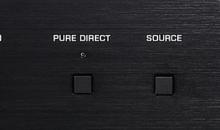Using In-wall Speakers
At one time I wished everyone could have gigantor speakers—tower speakers that would make sense only in a room with 12-foot tall ceilings occupied by former NBA stars walking around on stilts. I like big speakers. I like them because they typically provide no-holds-barred sound quality. With large speakers, you don’t need to compromise on aesthetics or frequency response. You can have it all. As I’ve matured, however, I’ve realized that I can accomplish a lot with smaller speakers, and I’ve also come to recognize that some homes simply have a beautiful aesthetic that doesn’t need to be interrupted by a large piece of audio “furniture”.
And it’s through that realization that I’m going to talk about In-wall Speakers. This isn’t a discussion of in-ceiling speakers for sound distribution. This article is about using in-wall speakers to provide primary sound for a home theater or listening room in a way that creates a beautiful sound quality without requiring a high level of interference with the layout or design of a living space.
In-wall speakers can vary in price as much as speakers having a standard enclosure. You can pick up a pair of in-walls for around $180, or you can spend upwards of $3,000 for a really high-end pair of speakers that provide uncompromising sound, even though they fit in between the stud cavity of your wall.
Installation Concerns of In-wall Speakers
In-wall speakers compromise the sound in only one way: They have a limited amount of depth and width that constrains the volume of the cabinet to that achievable by varying the height of the enclosure. Some in-wall speakers even utilize an “infinite baffle” design whereby the wall itself serves as the speaker box. These are less predictable since you may have different insulation materials in the wall (or none at all) and you may also have cross-bracing within the middle of the wall that will further constrain or alter the volume of the natural “back box”. Any speaker that is THX certified must utilize a back box (to retain the certification in use).
The limited depth of an in-wall speaker also constrains the drivers used in the design. Since a typical wall cavity is 3-1/2″ deep, you have to utilize drivers that don’t exceed those measurements. A good in-wall speaker will install easily within the typical 16-inch-on-center stud wall. That gives them a maximum width of 14-1/2″ and a depth (as we mentioned earlier) of 3-1/2″. Many in-wall speakers are narrower than 14-1/2″ in width and will utilize plastic clamps that can be tightened from the front similar to an old work electrical box. This allows it to clamp fast to the drywall with a secure connection.
In-wall speakers are actually quite easy to wire up since you are essentially cutting out a huge hole in the wall in which to place the speaker. This makes it much easier to access the wire when running it down the wall from an attic or upwards from a crawl space. All in-wall speakers will come with a cut-out template to let you know the exact dimensions you need for a perfect installation. These are typically traceable and take a lot of the guesswork out of the equation.
Sonic Characteristics of In-wall Speakers
Since in-wall speakers are almost always a function of aesthetics, there is a slight sonic quality compensation going on with all of these products. It’s important to understand, however, that designers know what’s going on here. For one, they compensate for “boundary gain”—the condition whereby a speaker closer to a wall (or in this case, in the wall) emits more bass frequencies. Boundary gain is a factor of room acoustics that is simply unavoidable. Place a speaker close to a wall and you’ll hear more low frequencies overall. When in-wall speakers are tuned, they are done so while they are in a wall. The enclosure and the drivers are all made with this in mind so that when you get them home and put them, in place, the system sonically matches the sound you’d get from a speaker placed further out into the room.
In-wall speakers also can’t be “toed-in” or turned towards the listening position. This means that you really need to match the style of speaker to your room. A large pair of contemporary speakers, for example, is simply not going to sound good if your listening position is 8 feet away. They won’t have enough room to converge and form a proper sound image at the listening position. If your sweet spot is closer to the walls, then you should consider a high-quality pair of speakers that are designed for closer proximity. This is one of those cases where less is more. Or you can go for the larger speakers and blow out the back of your room to give you a larger listening space—who are we to stop progress!
Using In-wall Speakers with Surround Sound
There really are no particular hangups when using in-wall speakers within the context of a full surround sound system. In fact, about the only speaker you may have an issue with is the center channel. There are two solutions for in-wall center channels. One is that you have ample room either above or below your television to mount the speaker so that it functions effectively at anchoring the center channel sound to your TV, or you are using a perforated projector screen whereby the center channel speaker can be mounted directly behind the action (just like in a real commercial movie theater).
Aside from that, Surround speakers and Surround Back channels work just fine with in-wall speakers—and even in-ceiling speakers can work well for these channels. There are now in-wall subwoofers that are excellent solutions for adding that low-end sound when you can’t place a big box in your living space. These used to be ultra-boxy solutions that needed to be attic-mounted (some of those products are still pretty cool), but now you can find 14-12″ wide models that will work within an available stud cavity.

DOs and DON’Ts
I can’t sign off without a brief list of dos and don’ts for using in-wall speakers. So without additional introduction, here they are:
Do:
- Choose an in-wall speaker size that will image well at the listening position
- Mount a center channel above or below a display
- Use the cut-out template that comes with the speaker for the best fit
- Use in-ceiling mounting positions for surround speakers when you cannot get the correct sidewall placement
Don’t:
- Pick a huge in-wall speaker when you are sitting too close to appreciate the sound of it
- Mount your center channel to the side of your TV
- Mount your in-wall speakers above the height of your television
- Mount front or center channel speakers in a ceiling
Overall I think that using in-wall speakers can solve quite a few problems. Consequently, they have really found a place in my heart. It’s taken years, but I’ve been in enough homes to gain an appreciation for maintaining the look of an older historic home, or the feel of a nice country atmosphere. I can always argue for plopping a speaker down as a beautiful piece of furniture to add to the room, but I also recognize the need for the in-wall speaker and am no longer in opposition to people requesting one for their installation.







is there any way to limit or stop the sound from being heard in the room on the other side of the wall ? i have inwall speakers in my living room but they can be heard thru the wall in an adjoining bedroom on the other side of the wall. i’ve been told that there is really nothing that can be done about it, it’s a side effect of inwall speakers. i find that hard to believe.
You’d need a double wall with an air gap to truly decouple the rooms.
Hi
I have a quite little space to have a 5.1. and at the same time I wanted to use two Hi-Fi speakers for the principle Left and Right channels. That said I wanted to create an ad hoc furniture including the LR speakers and the center of 5.1.
I’d like to know if I could use the in wall speakers mounted inside the furniture and which tricks i have to implements to have them working at the best.
Thank you